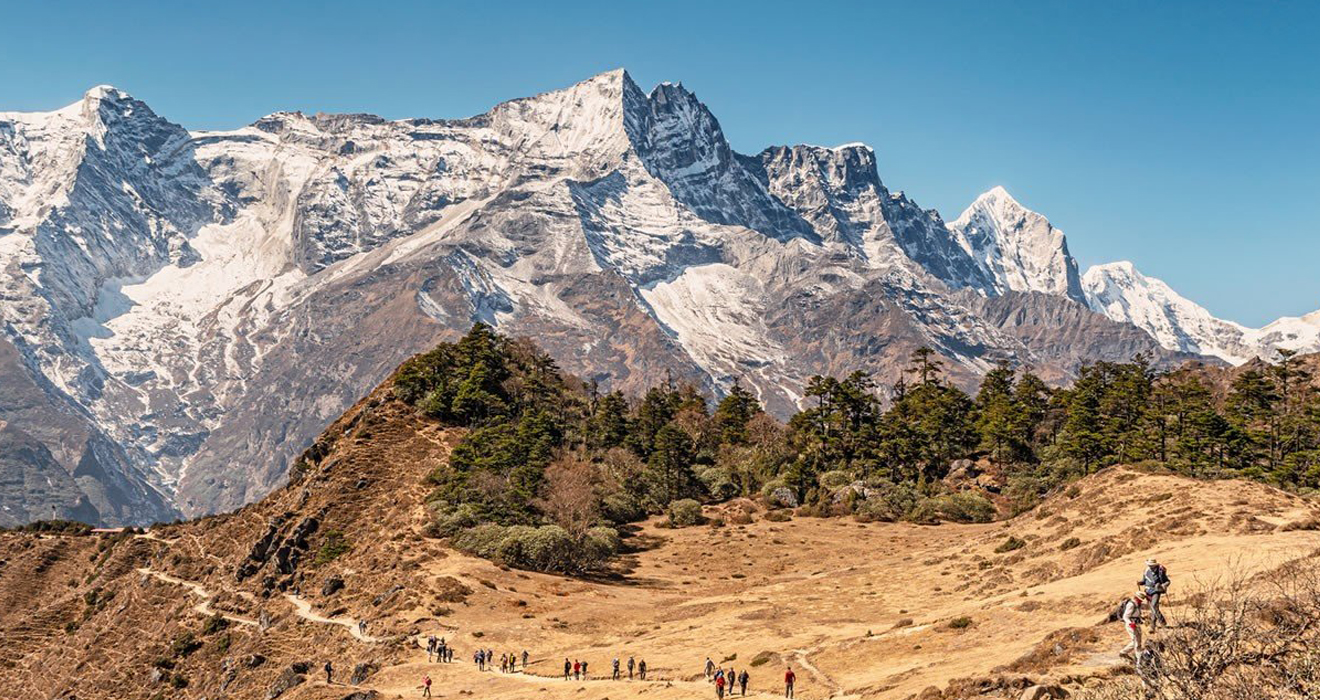At 3,500 feet, Namche Bazaar serves as the base camp for trips to Everest Base Camp and other Himalayan summits. The little, bright town has everything you would need, from climbing and trekking equipment to Tibetan antiquities. The park headquarters visitor center has information about several climbs in the area, mementos from past climbing expeditions, and details about the culture and way of life of the Sherpa people.
Located on the slope of an arch-shaped mountain, the medieval trading center—famous for its cheese and butter—offers breathtaking views of the massive Himalayan peaks from anywhere in the valley. In the past, Sherpas from nearby villages and traders from Tibet would come together to exchange commodities that showcased enticing indigenous arts and crafts. Additionally, Namche Bazaar used to be the main trading hub for the Khumbu region. Namche Bazaar has maintained its ancient customs, cultures, and hospitality in spite of its current state of prosperity.
One of the most well-known stops on the Everest Trek route is the village, which is controlled by Sherpas. In addition to the standard lodging options, dining options, and equipment retailers, this site also has a cyber cafe, a bar, and a pool area. It is advised that you remain here for a few days in order to walk around the area and acclimate to the altitude. A few hours’ walk from Namche Bazaar is Syangboche, or Sherpa communities like Khumjung, Thame, and Khunde, which can aid in your adjustment.
Every Saturday morning, Namche Bazaar hosts a weekly market fair that highlights the middle section of the town, where vendors are attempting to draw in new clients. Trekkers and mountain climbers can now do their last-minute shopping at Namche Bazaar.
Trekking in Nepal
Since Col. Jimmy Roberts arranged the first commercial trek in the 1960s, Nepal has drawn hikers from all over the world. The most popular tourism industry in Nepal is trekking, with thousands of visitors coming to experience the Himalayas. The most well-known trekking destinations are Everest and Annapurna; the districts of Langtang and Kanchenjunga also include some well-known hiking destinations.
The most difficult route, which stretches across Nepal from the west to the east via Humla, Darchula, and Kanchenjunga, is the Great Himalayan Trail. The lowest point in Nepal is located in the Terai region at 59 meters above sea level, whereas Everest, at 8,848 meters, is the highest point. It’s barely 200 kilometers separating the two locations.
The majority of hikers enter Nepal through the international airport, and they must obtain their permits and any other necessary paperwork in Kathmandu. All along the trekking path, the papers are inspected.
Trekking today takes place in very different environments than it did in the past. In the primary trekking regions, lodges for National Parks and Conservation Areas have now been built. Most of the time, the trails are labeled and kept in good condition.
Meet the People
There are many different ethnicities, tribes, civilizations, and faiths in Nepal, a nation known for its extraordinary diversity. Nepal, with its more than 100 ethnic groupings, is essentially a linguistic and ethnic mashup. Some parts of the nation have kept up with the times, but others are still trapped in the past because they are inaccessible. You can observe them carrying items to and from far-off settlements with mules. Fields are plowed by oxen as blacksmiths forge tools. In the communities, firewood serves as a primary energy source for cooking.
The lights and glamour of the city may make life seem alluring, yet the customs and cultures are still followed just as they were centuries ago.
Places to Visit in Namche Bazaar
Tengboche Monastery
Tengboche Monastery, one of the most well-known in Nepal, is situated against the backdrop of Mount Ama Dablam. It is the premier Buddhist center in the Khumbu area, home to a resident Rinpoche who bestows blessings on passing pilgrims, mountain climbers, and visitors. Every October, this place hosts the vibrant Mani Rimdu festival, the height of Buddhist revelries complete with ritual dances, religious ceremonies, and music. Since trekkers can participate in the celebration, many schedule their treks to coincide with it. The tourists are given a tour of the monastery every afternoon. Tengboche is located along the well-known Everest region trekking route.
The most popular night stop after Namche is Tengboche, which is perched on a hill across Imja Khola. It’s on a high ridge across the canyon from Khunde. The original monastery burned down in 1989, but it was rebuilt with a stronger framework. The monastery offers a broad view of Lhotse, Mount Everest, and Ama Dablam and is encircled by pine trees, brilliant rhododendrons, and azaleas. This area offers a wide variety of lodging options.
From Tengboche, you can travel to Pheriche, the hamlet of Gorak Shep, and Kala Pattar. From here, it’s easy to reach the Everest base camp.
Sagarmatha National Park
Several peaks above 6,000 meters may be found in the region, which was designated a national park in 1976 and is home to the highest mountain in the world. It was designated as a World Heritage Site in 1979. Since most of the parks are above 3,000 meters, the landscape is untamed and composed of enormous boulders, glaciers, and deep canyons. With over 118 different species of birds, the park is home to a diverse range of wildlife. Along with a variety of wildlife, including the Himalayan tahr, musk deer, wolf, Ghoral, serow, and Himalayan black bear, the forest is home to many birch, silver fir, rhododendron, and juniper trees. This area is home to several endangered species, including the snow leopard, red panda, and two magnificent pheasants.
Less than 2,000 meters above sea level is Jiri’s altitude, while the Himalaya is almost 8,000 meters above sea level. Because of this, the park has a broad range of plants and animals, including extensive forests of pine and oak and rhododendron, which may be found up to 4,000 meters above sea level. October and November are the finest months to visit the park.
Everest Base Camp
Trekkers rank the Everest Base Camp Trek as one of their top priorities. The two-week journey begins and ends at the airfield in the southern part of the area called Lukla. The trek normally starts with a flight to Lukla.
We begin our two-day easy hike up Dudh Koshi in Lukla and end up in the well-known Namche Bazaar. There are a lot of teahouses along the route. Monjo and Phakding are the most frequented stopovers on the first day. The Sagarmatha National Park entry, past Monjo, at the Jorsale checkpoint, where permits are examined. You will begin climbing from the suspension bridge a little distance from Jorsale and arrive in Namche Bazaar in three hours. It is advised that you stay
After leaving Namche Bazaar, the trail heads to the valley of Imja Khola, where breathtaking views of the Kangtega, Thamserku, and Ama Dablam mountains can be found. The skies are obscured by the Lhotse and Everest. After Namche, Tengboche is the most well-known rest area. After that, the trail descends via Pangboche till it reaches Dingboche or Pheriche.
Lobuche, located on the lateral moraine of the Khumbu glacier, is a 6-hour hike from Pheriche. It takes three hours to go to the Gorak Shep village from Lobuche. There are a few tea houses that offer lodging. Above Gorak Shep lies Kala Patthar, an excellent spot for mountain photography. The hike along the glacier to the base camp can take up to five hours. Because there is a chance of falling and the road is slick, exercise extreme caution.

Doris Pollard, a mesmerizing wordsmith and experienced blogger, crafts narratives that carry readers into unexplored realms. Infused with insightful perspectives and vibrant storytelling, Doris’s mastery of language captivates both hearts and minds, making an enduring impression on the literary landscape.

